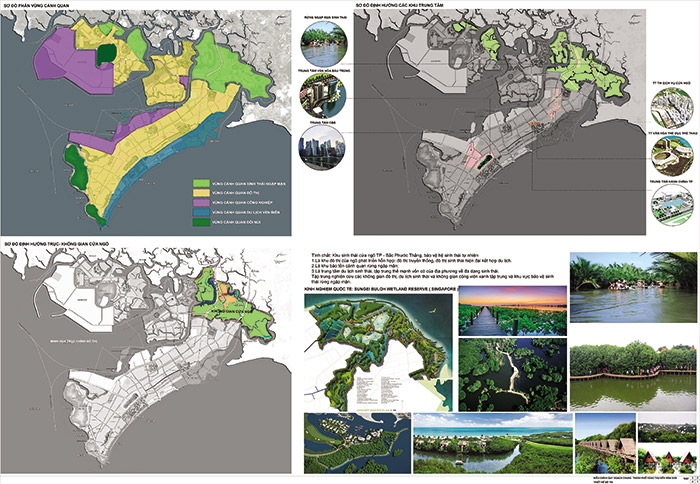Vung Tau revised its master plan to lure investments
 |
| It is hoped that Vung Tau can utilise the city’s resources and favourable location to maximise its trade potential |
As a major urban hub in the southern province of Ba Ria-Vung Tau and just 120 kilometres from Ho Chi Minh City, Vung Tau has the abundant natural resources to grow into a major national centre for petroleum services exploitation, as well as for tourism and seafood services.
The city’s general planning was first approved by the prime minister in 1993 and the second time in 2005. Some contents can no longer fit current development given the robust pace of local economic transformation and constant growth in social and economic development criteria.
The planning scheme, which was approved in 2005 and is still in effect today, controls the height of buildings and fails to create an impression of a city in development. In addition, many functional zones do not match the current context amid rapid urbanisation.
In May 2017, the prime minister approved a proposal to revise the city’s general planning. Based on the task, the Vung Tau People’s Committee has worked on the revised planning which was circulated for public comment and received strong support.
Vung Tau’s revised planning with a vision towards 2035, which covers about 15,000-hectare space and an estimated official population of about 650,000 people, has then been submitted to the prime minister for approval.
In the words of Mai Ngoc Thuan, Secretary of the Vung Tau Party Committee, the revised planning aims to bring sweeping changes, helping to turn Vung Tau into a modern metropolis, and once approved, it will need a great deal of effort from both city leaders and people to make the ambitions come true.
A major highlight in the planning reform is that no limit will be set to the height of buildings, with only the total floor and land area kept under control. There are exceptions for areas near mountains, with the height of buildings not surpassing two thirds of the mountain height.
The changes aim to create a hallmark to the city’s development through having in place modern and magnificent buildings to meet burgeoning construction demands amid increasingly scarce land funds.
The city will feature 10 major sub-zones with clear functions for each zone. The draft also envisages relocating a helicopter airport from Ward 9 to Go Gang area, which is set to become a financial and economic hub of national and international significance.
Notably, the Vietnam Institute for Urban and Rural Planning has referred to France’s Law on Urban Planning in respect to the imposition of height restrictions. Accordingly, to preserve existing salt-marsh ecosystems in the city, the consultancy unit has proposed construction density of less than 15 per cent and minimises high-construction density in these areas.
Green tree planning is set at 10 square metres per person at least, which matches first-grade, green city standards.
“It is hoped that the new revised planning will help Vung Tau particularly to attract large-scale investment projects, and from there push forward local socio-economic development in the upcoming years,” said Nguyen Lap, Chairman of the Vung Tau People’s Committee. “It will also serve as a strong legal base for the approval of diverse sub-zone planning, and the implementation of important investment projects.”
What the stars mean:
★ Poor ★ ★ Promising ★★★ Good ★★★★ Very good ★★★★★ Exceptional
Related Contents
Latest News
More News
- Sun Group breaks ground on $2 billion Van Don casino complex (December 19, 2025 | 18:14)
- Rare, beautiful, sustainable: the mark of iconic real estate (December 19, 2025 | 08:00)
- Owner-occupied housing stabilises, paving the way for new growth cycle (December 18, 2025 | 17:04)
- Unlocking urban potential of smart cities (December 18, 2025 | 16:50)
- Green finance offers 'passport' for Vietnamese construction, building materials firms (December 15, 2025 | 08:00)
- Gamuda Land commit long-term investment (December 12, 2025 | 11:49)
- HITC ties up with Evolution to develop AI and hyperscale data centres in Vietnam (December 11, 2025 | 12:09)
- Real estate deals boom via high-profile names (December 08, 2025 | 11:32)
- Industrial segment shaped by M&As (December 08, 2025 | 08:00)
- The Privé sets the benchmark for luxury real estate (December 05, 2025 | 08:28)

 Tag:
Tag:





















 Mobile Version
Mobile Version